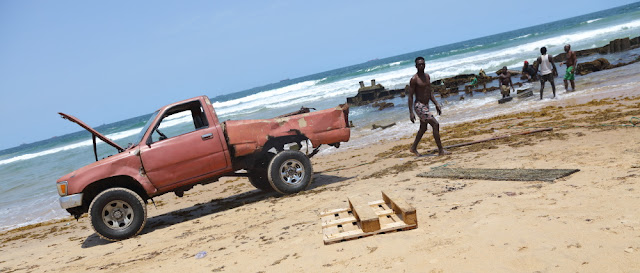 |
| guys, let's get it done while the tide is low |
Low tide is a blessing in Ilashe. Waves are much less powerful than during high tide making bathing very pleasant for those who want take a dip in the warm water. The sea also uncovers some surprises. The seashore is punctuated by abandoned ship wrecks. Some of them appear only at low tide, covered by algae. This means money opportunity for local communities who engage in the dismantling of those remains.
Andrew Anetor is leading a team of young athletic boys, about 7 of them, to break those metallic structures into pieces that are small enough to be carried at the back of his pick-up. He was raised in the UK and lived in a few countries abroad before coming back to Nigeria. He resides in Tarkwa Bay and scrap metal collection for recycling has become his bread-earner.
 |
| Andrew Anetor and the dismantlers |
Very short white hairs are perceptible on this face. He probably shaved a few days ago. His face is weathered and he probably got severely burnt on one side of his body where his skin looks regrown. He must be one of the leaders (Baba) of Tarkwa Bay because he owns a rather run-down pink-faded pick-up which is an essential tool to transport pieces of scrap metal from the shore to the recycling facilities owned by either Chinese or Indian people. The pick-up looks likely to breakdown anytime but his driver must have developed a particularly intimate knowledge of the mechanics to be able to bring it back to work whenever it breaks down. A tailored pampering regime in other words. But it is well worth it since the pick-up is heavy duty and adapted to driving in the sand with a full load.
We saw the vehicle coming from far with two men standing at the back, dressed in dark colours. At first sight, the shape of the pick-up, the sand, the seaside and the figures of the two men was a chilling view as they could have been smugglers, kidnappers of the kind plying the Sahara desert. But that was just a momentary illusion!
 |
| pick-up for scrap collection cooling down |
As a matter of fact, the boys are solidly built to be able to carry out the heavy duty work which earns them a living.
Andrew explained that a ton of scrap metal is worth sixty thousand naira (between 150 and 200 dollars) and that he is usually able to collect two tons a day. He pays his boys two thousand naira a day, a very decent salary for those boys who would otherwise be probably without a proper job or keeping themselves busy with less commendable activities.
 |
| cutting torch in action |
Strength and agility are key skills to be able to break the wreck structure into pieces. The team uses a hoisting mechanism with a heavy chain and two hooks that they adjust on protruding parts of the wreck and then manually tighten the chain to break down the rusted structure into smaller pieces, that can then be dragged back to the sand. There, a man, with a Superman hat, uses a cutting torch to further cut the metal into smaller pieces that can be loaded at the back of the pick-up.
Anyone looking for a beach job?




Very nice job
ReplyDelete